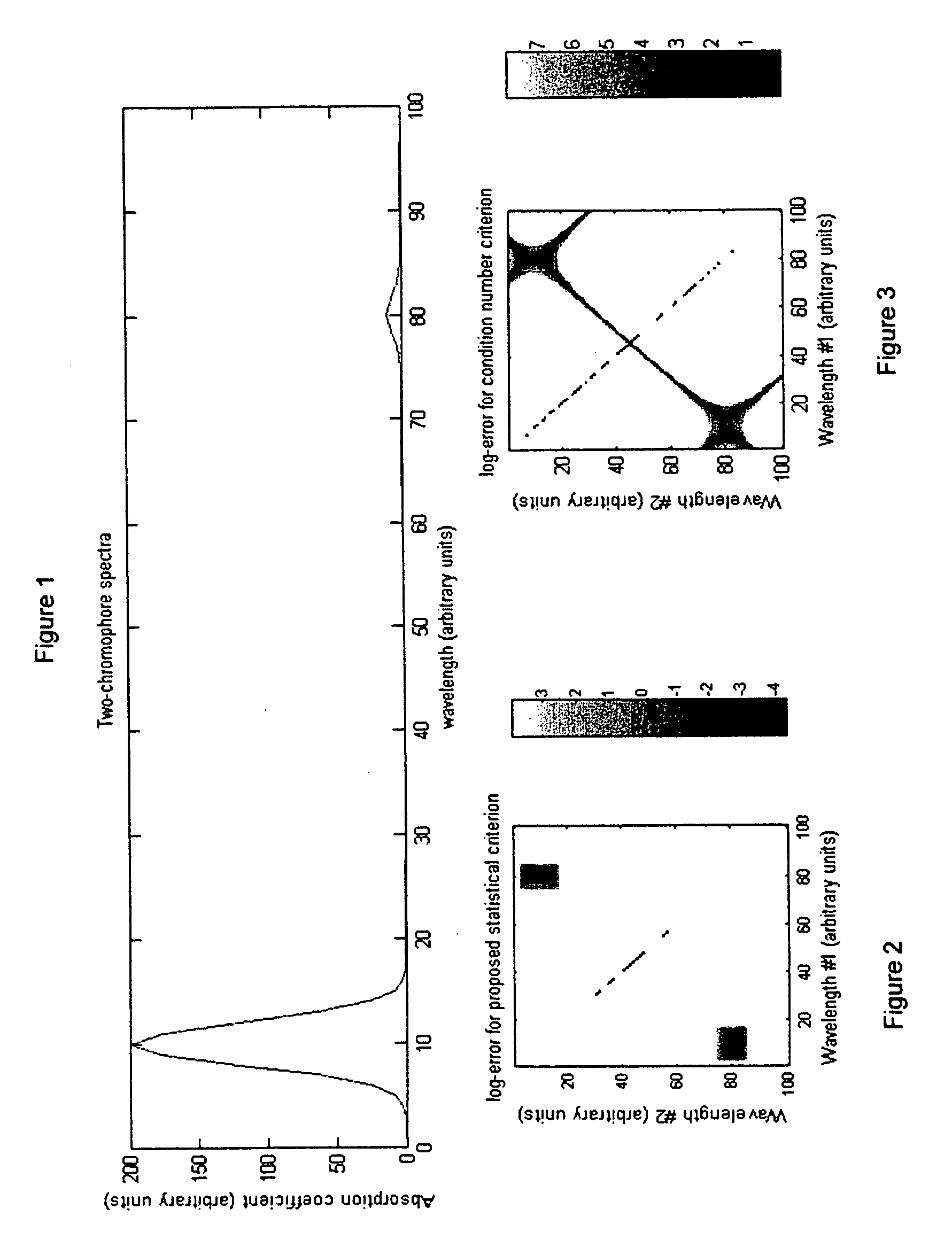Method for selecting wavelengths for optical data acquisition
a wavelength selection and optical data technology, applied in the field of optical data acquisition, can solve the problems of reducing oxygen saturation, affecting the diagnostic accuracy of optical imaging, and unable to determine whether the spatial resolution provided by optical imaging is adequate for diagnosing, so as to improve optical image quality and improve optical data acquisition
- Summary
- Abstract
- Description
- Claims
- Application Information
AI Technical Summary
Benefits of technology
Problems solved by technology
Method used
Image
Examples
example 1
[0062] Optimisation Based Upon the Condition Number:
wavelengths (nm):735760795835
[0063] expected %-error of the concentrations:
HbR (deoxy-haemoglobin):2.9987HbO2 (oxy-haemoglobin):5.9960Water:25.6071Lipid:26.1913
[0064] condition number for this set: 36.3741
[0065] Optimisation Based Upon the Proposed Criterion:
wavelengths (nm):690735760805
[0066] expected %-error of the concentrations:
HbR (deoxy-haemoglobin):1.2041HbO2 (oxy-haemoglobin):4.7867Water:19.1384Lipid:24.7224
[0067] condition number for this set: 42.7687
example 2
[0068] In another example let us assume that there are only two chromophores and two wavelengths (see FIG. 1). We also assume that the absorption spectra for those chromophores come in the form of delta-like function, i.e. each chromophore only absorbs close to one specific wavelength, and those two wavelengths are well separated. Finally, we assume that one of the two chromophores is overall much less absorbent than the other, each taken at their respective absorption wavelength.
[0069] Obviously, the optimal choice of wavelength in this case should be the peak values of each spectrum. However, the condition number criterion will not give that result. Take a1 and a2 to be the peak values of the spectra of the two chromophores, with α1 α2. In this case, the matrix A has α1 and α2 on the diagonal, and zero everywhere else. The condition number of this matrix is trivially found to be equal to α2 / α1, a large number. Yet if we were to choose an off-peak value for the second chromophore,...
example 3
[0070] In the text above, we proposed a criterion for wavelength optimization that differs from the standard condition number criterion, avoiding certain problems encountered when using the latter. We present here comparison between the two methods, and conclude by proposing new set of optimal wavelengths.
[0071] We present four different optimization schemes:
[0072] One with standard concentrations of the four chromophores, namely deoxyhemoglobin (HbR) and oxyhemoglobin (HbO2) at 1.0 micro-Mole water at 18% and lipid at 70%. Since absorption of lipids is much smaller than the three other chromophores at these typical concentrations (using the olive oil spectrum), the optimization is completely dominated by the former while it also is the least significant diagnostically.
[0073] We propose a second scheme where only the error over HbR, (HbO2) and water is minimized, which leads to a second set of wavelengths.
[0074] A third set is obtained in the case where assign weights of [1,1,0....
PUM
| Property | Measurement | Unit |
|---|---|---|
| wavelength | aaaaa | aaaaa |
| optical information | aaaaa | aaaaa |
| wavelengths | aaaaa | aaaaa |
Abstract
Description
Claims
Application Information
 Login to View More
Login to View More - R&D
- Intellectual Property
- Life Sciences
- Materials
- Tech Scout
- Unparalleled Data Quality
- Higher Quality Content
- 60% Fewer Hallucinations
Browse by: Latest US Patents, China's latest patents, Technical Efficacy Thesaurus, Application Domain, Technology Topic, Popular Technical Reports.
© 2025 PatSnap. All rights reserved.Legal|Privacy policy|Modern Slavery Act Transparency Statement|Sitemap|About US| Contact US: help@patsnap.com



